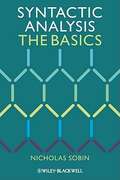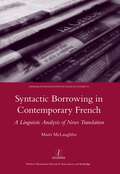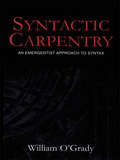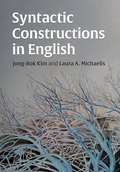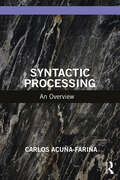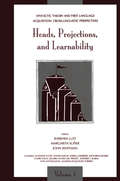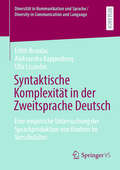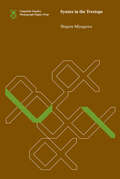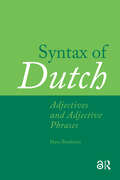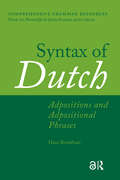- Table View
- List View
Symptomatic Subjects: Bodies, Medicine, and Causation in the Literature of Late Medieval England (Alembics: Penn Studies in Literature and Science)
by Julie OrlemanskiIn the period just prior to medicine's modernity—before the rise of Renaissance anatomy, the centralized regulation of medical practice, and the valorization of scientific empiricism—England was the scene of a remarkable upsurge in medical writing. Between the arrival of the Black Death in 1348 and the emergence of printed English books a century and a quarter later, thousands of discrete medical texts were copied, translated, and composed, largely for readers outside universities. These widely varied texts shared a model of a universe crisscrossed with physical forces and a picture of the human body as a changeable, composite thing, tuned materially to the world's vicissitudes. According to Julie Orlemanski, when writers like Geoffrey Chaucer, Robert Henryson, Thomas Hoccleve, and Margery Kempe drew on the discourse of phisik—the language of humors and complexions, leprous pustules and love sickness, regimen and pharmacopeia—they did so to chart new circuits of legibility between physiology and personhood.Orlemanski explores the texts of her vernacular writers to show how they deployed the rich terminology of embodiment and its ailments to portray symptomatic figures who struggled to control both their bodies and the interpretations that gave their bodies meaning. As medical paradigms mingled with penitential, miraculous, and socially symbolic systems, these texts demanded that a growing number of readers negotiate the conflicting claims of material causation, intentional action, and divine power. Examining both the medical writings of late medieval England and the narrative and poetic works that responded to them, Symptomatic Subjects illuminates the period's conflicts over who had the authority to construe bodily signs and what embodiment could be made to mean.
Synaesthesia and the Ancient Senses: Synaesthesia And The Ancient Senses (The Senses in Antiquity)
by Shane Butler Alex PurvesLike us, the ancient Greeks and Romans came to know and understand the world through their senses. Yet sensory experience has rarely been considered in the study of antiquity and, when the senses are examined, sight is regularly privileged. 'Synaesthesia and the Ancient Senses' presents a radical reappraisal of antiquity's textures, flavours, and aromas, sounds and sights. It offers both a fresh look at society in the ancient world and an opportunity to deepen the reading of classical literature. The book will appeal to readers in classical society and literature, philosophy and cultural history. All Greek and Latin is translated and technical matters are explained for the non-specialist. The introduction sets the ancient senses within the history of aesthetics and the subsequent essays explores the senses throughout the classical period and on to the modern reception of classical literature.
Syntactic Analysis: The Basics
by Nicholas SobinOffers a hands-on approach to understanding and performing syntactic analysis and introduces students to linguistic argumentation.
Syntactic Analysis: The Basics
by Nicholas SobinHighly readable and eminently practical, Syntactic Analysis: The Basics focuses on bringing students with little background in linguistics up to speed on how modern syntactic analysis works. A succinct and practical introduction to understanding sentence structure, ideal for students who need to get up to speed on key concepts in the field Introduces readers to the central terms and concepts in syntax Offers a hands-on approach to understanding and performing syntactic analysis and introduces students to linguistic argumentation Includes numerous problem sets, helpfully graded for difficulty, with model answers provided at critical points Prepares readers for more advanced work with syntactic systems and syntactic analyses
Syntactic Argumentation and the Structure of English
by Scott Soames David M. PerlmutterSyntactic Argumentation and the Structure of English (SASE) presents the major theoretical developments in generative syntax and the empirical arguments motivating them. Beautifully and lucidly written, it is an invaluable resource for working linguists as well as a pedagogical tool of unequaled depth and breadth. The chief focus of the book is syntactic argumentation. Beginning with the fundamentals of generative syntax, it proceeds by a series of gradually unfolding arguments to analyses of some of the most sophisticated proposals. It includes a wide variety of problems that guide the reader in constructing arguments deciding between alternative analyses of syntactic constructions and alternative theoretical formulations. Someone who has worked through the problems and arguments in this book will be able to apply the skills in argumentation it develops to novel issues in syntax. While teaching syntactic argumentation, SASE covers the major empirical results of generative syntax. Its contents include: 1) Transformations in single-clause sentences2) Complementation and multi-clause transformations3) Universal principles governing rule interaction: the cycle and strict cyclicity4) Movement rules5) Ross's constraints6) Pronominal reference and anaphora SASE is an important book for several different audiences:1) For students, it is an introduction to syntax that teaches argumentation as well as a wide range of empirical results in the field. 2) For linguists, it is a sourcebook of classical analyses and arguments, with some new arguments bearing on classical issues. 3) For scholars, teachers, and students in related fields, it is a comprehensive guide to the major empirical and theoretical developments in generative syntax. SASE contains enough material for a two-semester or three-quarler sequence in syntax. Because it assumes no previous background, it can be used as the main text in an introduction to syntax. Since it covers a wide range of material not available in other texts, it is also suitable for intermediate and advanced syntax courses and as a supplementary source in more specialized courses and courses in other disciplines. A storehouse of classical and original arguments, SASE will prove to be of lasting value to the teacher, the student, and researchers in both linguistics and related fields.
Syntactic Borrowing in Contemporary French: A Linguistic Analysis of News Translation
by Mairi MaLaughlinIt is widely held that the large-scale translation of international news from English will lead to changes in French syntax. For the first time this assumption is put to the test using extensive fieldwork carried out in an international news agency and a corpus of translated news agency dispatches. The linguistic analysis of three syntactic structures in the translations is complemented by an investigation of the effects of a range of factors including, most notably, the speed at which the translation is carried out. The analysis sheds new light on the ways in which news translation could lead to syntactic borrowing in French, and by extension, in other languages.
Syntactic Carpentry: An Emergentist Approach to Syntax
by William O'GradySyntactic Carpentry: An Emergentist Approach to Syntax presents a groundbreaking approach to the study of sentence formation. Building on the emergentist thesis that the structure and use of language is shaped by more basic, non-linguistic forces—rather than by an innate Universal Grammar—William O'Grady shows how the defining properties of various core syntactic phenomena (phrase structure, co-reference, control, agreement, contraction, and extraction) follow from the operation of a linear, efficiency-driven processor. This in turn leads to a compelling new view of sentence formation that subsumes syntactic theory into the theory of sentence processing, eliminating grammar in the traditional sense from the study of the language faculty. With this text, O'Grady advances a growing body of literature on emergentist approaches to language, and situates this work in a broader picture that also includes attention to key issues in the study of language acquisition, psycholinguistics, and agrammaticism. This book constitutes essential reading for anyone interested in syntax and its place in the larger enterprise of cognitive science.
Syntactic Change in Late Modern English: Studies on Colloquialization and Densification (Studies in English Language)
by Erik SmitterbergSyntactic Change in Late Modern English presents a stability paradox to linguists; despite the many social changes that took place between 1700 and 1900, the language appeared to be structurally stable during this period. This book resolves this paradox by presenting a new, idiolect-centred perspective on language change, and shows how this framework is applicable to change in any language. It then demonstrates how an idiolect-centred framework can be reconciled with corpus-linguistic methodology through four original case studies. These concern colloquialization (the process by which oral features spread to writing) and densification (the process by which meaning is condensed into shorter linguistic units), two types of change that characterize Modern English. The case studies also shed light on the role of genre and gender in language change and contribute to the discussion of how to operationalize frequency in corpus linguistics. This study will be essential reading for researchers in historical linguistics, corpus linguistics and sociolinguistics.
Syntactic Constructions in English
by Jong-Bok Kim Laura A. MichaelisConstruction grammar (CxG) is a framework for syntactic analysis that takes constructions - pairings of form and meaning that range from the highly idiomatic to the very general - to be the building blocks of sentence meaning. Offering the first comprehensive introduction to CxG to focus on both English words and the constructions that combine them, this textbook shows students not only what the analyses of particular structures are, but also how and why those analyses are constructed, with each chapter taking the student step-by-step through the reasoning processes that yield the best description of a data set. It offers a wealth of illustrative examples and exercises, largely based on real language data, making it ideal for both self-study and classroom use. Written in an accessible and engaging way, this textbook will open up this increasingly popular linguistic framework to anyone interested in the grammatical patterns of English.
Syntactic Islands
by Cedric BoeckxThe phenomenon of the syntactic 'island' – a clause or structure from which a word cannot be moved – is central to research and study in syntactic theory. This book provides a comprehensive overview of syntactic islands. What are they? How do they arise? Why do they exist? Cedric Boeckx discusses the pros and cons of all the major generative accounts of island effects, and focuses the discussion on whether islands are narrowly syntactic effects, are due to interface factors or are 'merely' performance effects. Thanks to the diversity of island effects, readers are given a unique opportunity to familiarize themselves with all the major research styles and types of analysis in theoretical linguistics and have the chance to reflect on the theoretical implications of concrete natural language examples, allowing them to develop their own synthesis.
Syntactic Issues in the English Imperative (Outstanding Dissertations in Linguistics #20)
by Eric PotsdamFirst Published in 1998. This work is an unrevised version of my 1996 University of California, Santa Cruz Ph.D. dissertation. The only changes that have been made are corrections of typographical errors, minor rewording, updating of references, and the inclusion of an index. I would like to thank Rosemary Plapp and Kristi Long for help with proofreading and preparation of the manuscript.
Syntactic Issues in the English Imperative (Routledge Library Editions: Syntax #20)
by Eric PotsdamThis study, first published in 1998, provides a close investigation of central syntactic issues in the English imperative clause type. It argues that the imperative has largely regular syntactic behaviour within a conventional conception of English clause structure. This title will be of interest to students of language and linguistics.
Syntactic Processing: An Overview
by Carlos Acuña-FariñaThis book provides an overview of the structures, topics and main theories of syntactic processing. It covers the last 40 years of sentence-level psycholinguistic research and debates and makes it accessible to both theoretical linguists and experimental psychologists. Tying linguistically relevant issues to psycholinguistic theory, this book: Covers the processing of the grammatical phenomena adjunction, agreement and gap filling and discusses the relationship between grammars and parsers Discusses experimental work and theories, demonstrating how psychologists have made real strides in understanding language and how studying the processing of syntactic structure is the same as studying the nature of language Explores the key theories of psycholinguistics, including recent developments Explains the different methodologies of sentence processing, such as eye-tracking and electroencephalography Bridging the gap between psycholinguistic research and the study of language, this book is essential reading for advanced students and scholars of linguistics and experimental psycholinguistics as well as cognitive science and psychology.
Syntactic Theory and First Language Acquisition: Cross-linguistic Perspectives -- Volume 1: Heads, Projections, and Learnability -- Volume 2: Binding, Dependencies, and Learnability
by John Whitman Claire Foley Suzanne Flynn Barbara Lust Margarita Suñer Shyam Kapur Isabella Barbier Katharina Boser Zelmira Nuñez del Prado Edward J. Rubin Lynn Santelmann Almeida Jacqueline ToribioUniversal Grammar (UG) is a theory of both the fundamental principles for all possible languages and the language faculty in the "initial state" of the human organism. These two volumes approach the study of UG by joint, tightly linked studies of both linguistic theory and human competence for language acquisition. In particular, the volumes collect comparable studies across a number of different languages, carefully analyzed by a wide range of international scholars. The issues surrounding cross-linguistic variation in "Heads, Projections, and Learnability" (Volume 1) and in "Binding, Dependencies, and Learnability" (Volume 2) are arguably the most fundamental in UG. How can principles of grammar be learned by general learning theory? What is biologically programmed in the human species in order to guarantee their learnability? What is the true linguistic representation for these areas of language knowledge? What universals exist across languages? The two volumes summarize the most critical current proposals in each area, and offer both theoretical and empirical evidence bearing on them. Research on first language acquisition and formal learnability theory is placed at the center of debates relative to linguistic theory in each area. The convergence of research across several different disciplines -- linguistics, developmental psychology, and computer science -- represented in these volumes provides a paradigm example of cognitive science.
Syntactic Theory and First Language Acquisition: Cross-linguistic Perspectives -- Volume 1: Heads, Projections, and Learnability -- Volume 2: Binding, Dependencies, and Learnability
by Claire Foley Suzanne Flynn Jaklin Kornfilt Barbara Lust Shyam Kapur Isabella Barbier Katharina Boser Zelmira Nuñez del Prado Edward J. Rubin Lynn Santelmann Gabriella Hermon Jacqueline ToribioUniversal Grammar (UG) is a theory of both the fundamental principles for all possible languages and the language faculty in the "initial state" of the human organism. These two volumes approach the study of UG by joint, tightly linked studies of both linguistic theory and human competence for language acquisition. In particular, the volumes collect comparable studies across a number of different languages, carefully analyzed by a wide range of international scholars. The issues surrounding cross-linguistic variation in "Heads, Projections, and Learnability" (Volume 1) and in "Binding, Dependencies, and Learnability" (Volume 2) are arguably the most fundamental in UG. How can principles of grammar be learned by general learning theory? What is biologically programmed in the human species in order to guarantee their learnability? What is the true linguistic representation for these areas of language knowledge? What universals exist across languages? The two volumes summarize the most critical current proposals in each area, and offer both theoretical and empirical evidence bearing on them. Research on first language acquisition and formal learnability theory is placed at the center of debates relative to linguistic theory in each area. The convergence of research across several different disciplines -- linguistics, developmental psychology, and computer science -- represented in these volumes provides a paradigm example of cognitive science.
Syntactic Theory: A Unified Approach
by Robert BorsleySyntactic theory is central to the study of language. This innovative book introduces the ideas which underlie most approaches to syntax and shows how they have been developed within two broad frameworks: principles and parameters theory and phrase structure grammar. While other texts either concentrate on one theory or treat them as totally separate, here both approaches are introduced together, highlighting the similarities as well as the differences.Thoroughly updated in the light of major recent developments, this second edition includes expanded explanations of the main characteristics of the two theories, summaries of the main features, exercises reinforcing key points and suggestions for further investigation.
Syntactic n-grams in Computational Linguistics (SpringerBriefs in Computer Science)
by Grigori SidorovThis book is about a new approach in the field of computational linguistics related to the idea of constructing n-grams in non-linear manner, while the traditional approach consists in using the data from the surface structure of texts, i.e., the linear structure.In this book, we propose and systematize the concept of syntactic n-grams, which allows using syntactic information within the automatic text processing methods related to classification or clustering. It is a very interesting example of application of linguistic information in the automatic (computational) methods. Roughly speaking, the suggestion is to follow syntactic trees and construct n-grams based on paths in these trees. There are several types of non-linear n-grams; future work should determine, which types of n-grams are more useful in which natural language processing (NLP) tasks. This book is intended for specialists in the field of computational linguistics. However, we made an effort to explain in a clear manner how to use n-grams; we provide a large number of examples, and therefore we believe that the book is also useful for graduate students who already have some previous background in the field.
Syntaktische Komplexität in der Zweitsprache Deutsch: Eine empirische Untersuchung der Sprachproduktion von Kindern im Vorschulalter (Diversität in Kommunikation und Sprache / Diversity in Communication and Language)
by Ulla Licandro Edith Beaulac Aleksandra KappenbergIn Deutschland gibt es eine hohe Anzahl von Kindern, die erst in der Kindertageseinrichtung (Kita) systematischen Kontakt zur Umgebungssprache erhalten. Zur Untersuchung der Sprachentwicklung ein- und mehrsprachiger Kinder wird die Spontansprachanalyse empfohlen, welche im Hinblick auf Erwerbsmeilensteine ausgewertet wird. Das Wissen darüber, wie sich die syntaktische Komplexität von Kindern in ihrer Zweitsprache Deutsch entwickelt, ist allerdings noch lückenhaft. Im vorliegenden Buch wird eine Studie zur Produktion komplexer Sätze von 21 vier- bis sechsjährigen Kindern im Zweitspracherwerb während einer dialogischen Bilderbuchbetrachtung vorgestellt. Analysiert wurden die Produktion unterschiedlicher Satztypen sowie Zusammenhänge zwischen ihrer Produktion und Einflussfaktoren des Zweitspracherwerbs. Die Ergebnisse tragen zur Identifikation potenziell relevanter Parameter für die Untersuchung des Erwerbs syntaktischer Strukturen von Kindern im Vorschulalter bei.
Syntax
by Robert FreidinSyntax: Basic Concepts and Applications provides a systematic introduction to core topics in syntax, focusing on how the basic concepts apply in the analysis of sentences. Assuming no background in linguistic analysis, the book gives students a working knowledge of syntactic analysis from a minimalist perspective. Step by step it explains the fundamentals of phrase structure, movement and deletion. Well-placed exercises throughout reinforce and extend the concepts and analyses presented in the text, allowing readers to gain understanding of progressively complex issues at a comfortable pace. Much of the data comes from English, but crucial examples are also drawn from a range of other languages, including Russian, Chinese, Japanese, French, Italian, Spanish, Irish, Welsh and Greek.
Syntax in the Treetops (Linguistic Inquiry Monographs)
by Shigeru MiyagawaA proposal that syntax extends to the domain of discourse in making core syntax link to the conversational context.In Syntax in the Treetops, Shigeru Miyagawa proposes that syntax extends into the domain of discourse by making linkages between core syntax and the conversational participants. Miyagawa draws on evidence for this extended syntactic structure from a wide variety of languages, including Basque, Japanese, Italian, Magahi, Newari, Romanian, and Spanish, as well as the language of children with autism. His proposal for what happens at the highest level of the tree structure used by linguists to represent the hierarchical relationships within sentences—&“in the treetops&”—offers a unique contribution to the new area of study sometimes known as &“syntacticization of discourse.&” Miyagawa&’s main point is that syntax provides the basic framework that makes possible the performance of a speech act and the conveyance of meaning; although the role that syntax plays for speech acts is modest, it is critical. He proposes that the speaker-addressee layer and the Commitment Phrase (the speaker&’s commitment to the addressee of the truthfulness of the proposition) occur together in the syntactic treetops. In each succeeding chapter, Miyagawa examines the working of each layer of the tree and how they interact.
Syntax of Dutch: Adjectives and Adjective Phrases (Comprehensive Grammar Resources)
by Hans BroekhuisThe Syntax of Dutch will be published in at least seven volumes in the period 2012-2016 and aims at presenting a synthesis of the currently available syntactic knowledge of Dutch. It is primarily concerned with language description and not with linguistic theory, and provides support to all researchers interested in matters relating to the syntax of Dutch, including advanced students of language and linguistics. The volume Adjectives and Adjective Phrases discusses the internal make-up as well as the distribution of adjective phrases. Topics that will be covered include: complementation and modification of adjective phrases; comparative and superlative formation; the attributive, predicative and adverbial uses of adjective phrases. Special attention is paid to the so-called partitive genitive construction and the adverbial use of past/passive participles and infinitives.
Syntax of Dutch: Adpositions and Adpositional Phrases (Comprehensive Grammar Resources)
by Hans BroekhuisThe Syntax of Dutch will be published in at least seven volumes in the period 2012-2016 and aims at presenting a synthesis of the currently available syntactic knowledge of Dutch. It is primarily concerned with language description and not with linguistic theory, and provides support to all researchers interested in matters relating to the syntax of Dutch, including advanced students of language and linguistics., The volume Adpositions and Adpositional Phrases discusses the internal make-up and the distribution of adpositional phrases. Topics that are covered include complementation and modification of adpositional phrases, as well as their predicative, attributive and adverbial uses. A separate chapter is devoted to the formation and the syntactic behavior of pronominal PPs like 'on it', which also includes a more general discussion of the syntax of so-called R-words like er 'there'.
Syntax of Dutch: Coordination and Ellipsis (Comprehensive Grammar Resources)
by Norbert Corver Hans BroekhuisThe multi-volume work Syntax of Dutch presents a synthesis of current thinking on Dutch syntax. The text of the seven already available volumes was written between 1995 and 2015 and issued in print between 2012 and 2016. The various volumes are primarily concerned with the description of the Dutch language and, only where this is relevant, with linguistic theory. They will be an indispensable resource for researchers and advanced students of languages and linguistics interested in the Dutch language. This volume is the final one of the series and addresses issues relating to coordination. It contains three chapters. Chapter 1 discusses the syntactic and semantic properties of coordinate structures and their constituting elements, that is, the coordinators and the coordinands they link. Chapter 2 discusses the types of ellipsis known as conjunction reduction and gapping found in coordinate structures. Chapter 3 discusses elements seemingly exhibiting coordination-like properties, such as dan 'than' in comparative constructions like Jan is groter dan zij 'Jan is taller than she'.
Syntax of Dutch: Nouns and Noun Phrases - Volume 1 (Comprehensive Grammar Resources)
by Evelien Keizer Hans BroekhuisThe Syntax of Dutch will be published in at least seven volumes in the period 2012-2016 and aims at presenting a synthesis of the currently available syntactic knowledge of Dutch. It is primarily concerned with language description and not with linguistic theory, and provides support to all researchers interested in matters relating to the syntax of Dutch, including advanced students of language and linguistics.,The two volumes Nouns and Noun Phrases discuss the internal make-up as well as the distribution of noun phrases. Topics that will be covered include: complementation and modification of noun phrases; properties of determiners (article, demonstratives), numeral and quantifiers; the use of noun phrases as arguments, predicates and adverbial modifiers.
Syntax of Dutch: Nouns and Noun Phrases - Volume 2 (Comprehensive Grammar Resources)
by Hans Broekhuis Marcel DikkenThe Syntax of Dutch will be published in at least seven volumes in the period 2012-2016 and aims at presenting a synthesis of the currently available syntactic knowledge of Dutch. It is primarily concerned with language description and not with linguistic theory, and provides support to all researchers interested in matters relating to the syntax of Dutch, including advanced students of language and linguistics.,The two volumes Nouns and Noun Phrases discuss the internal make-up as well as the distribution of noun phrases. Topics that will be covered include: complementation and modification of noun phrases; properties of determiners (article, demonstratives), numeral and quantifiers; the use of noun phrases as arguments, predicates and adverbial modifiers.


